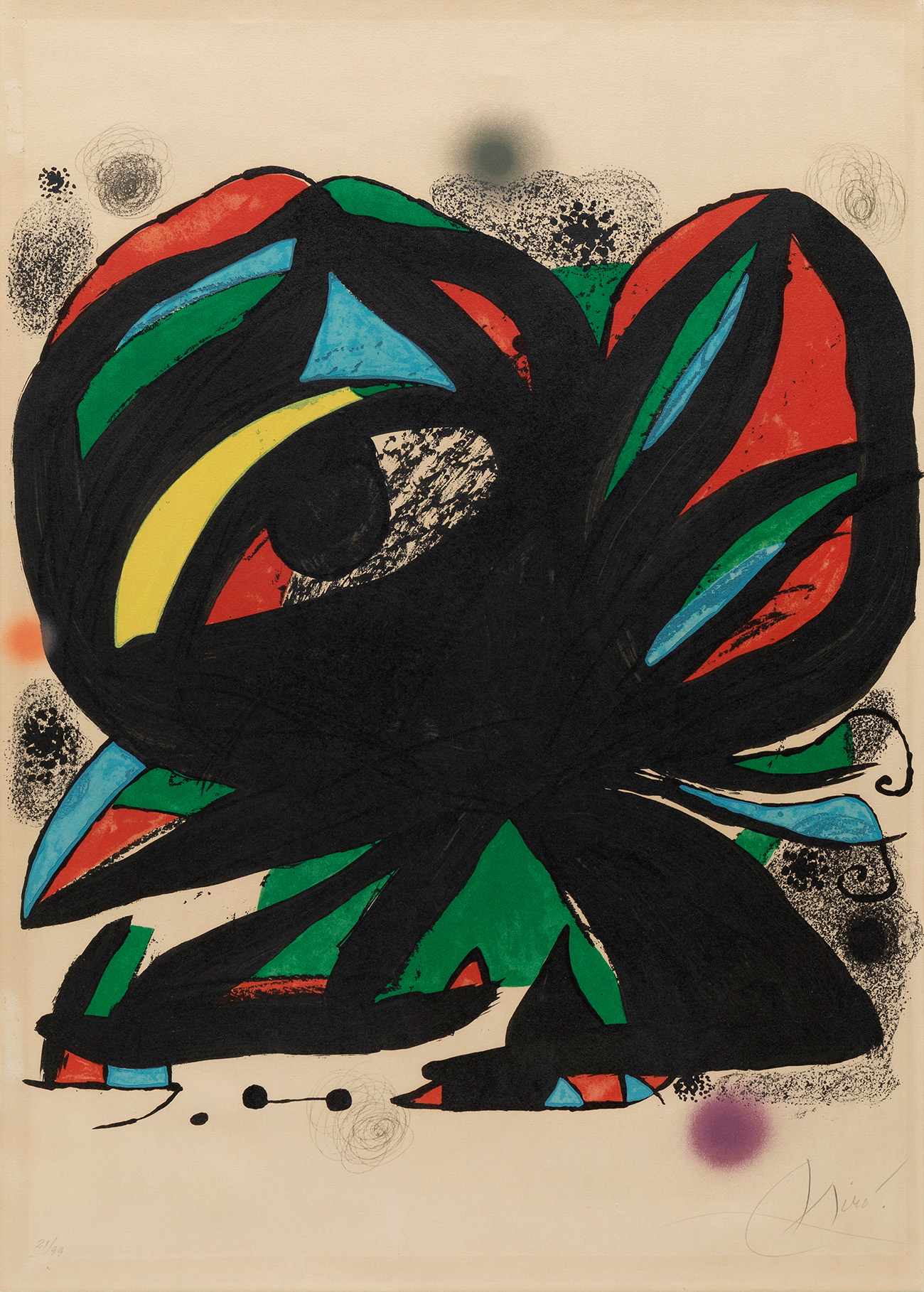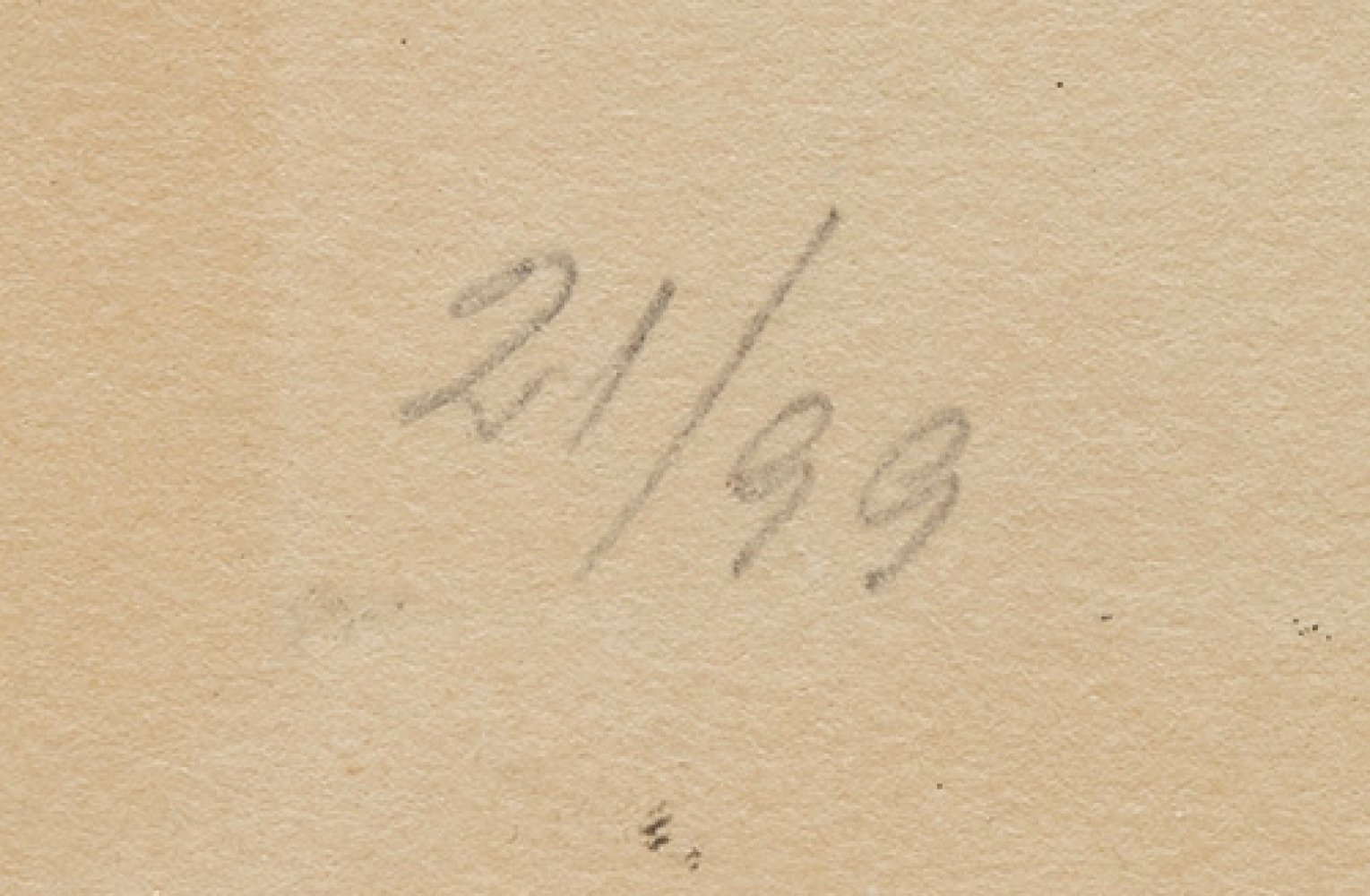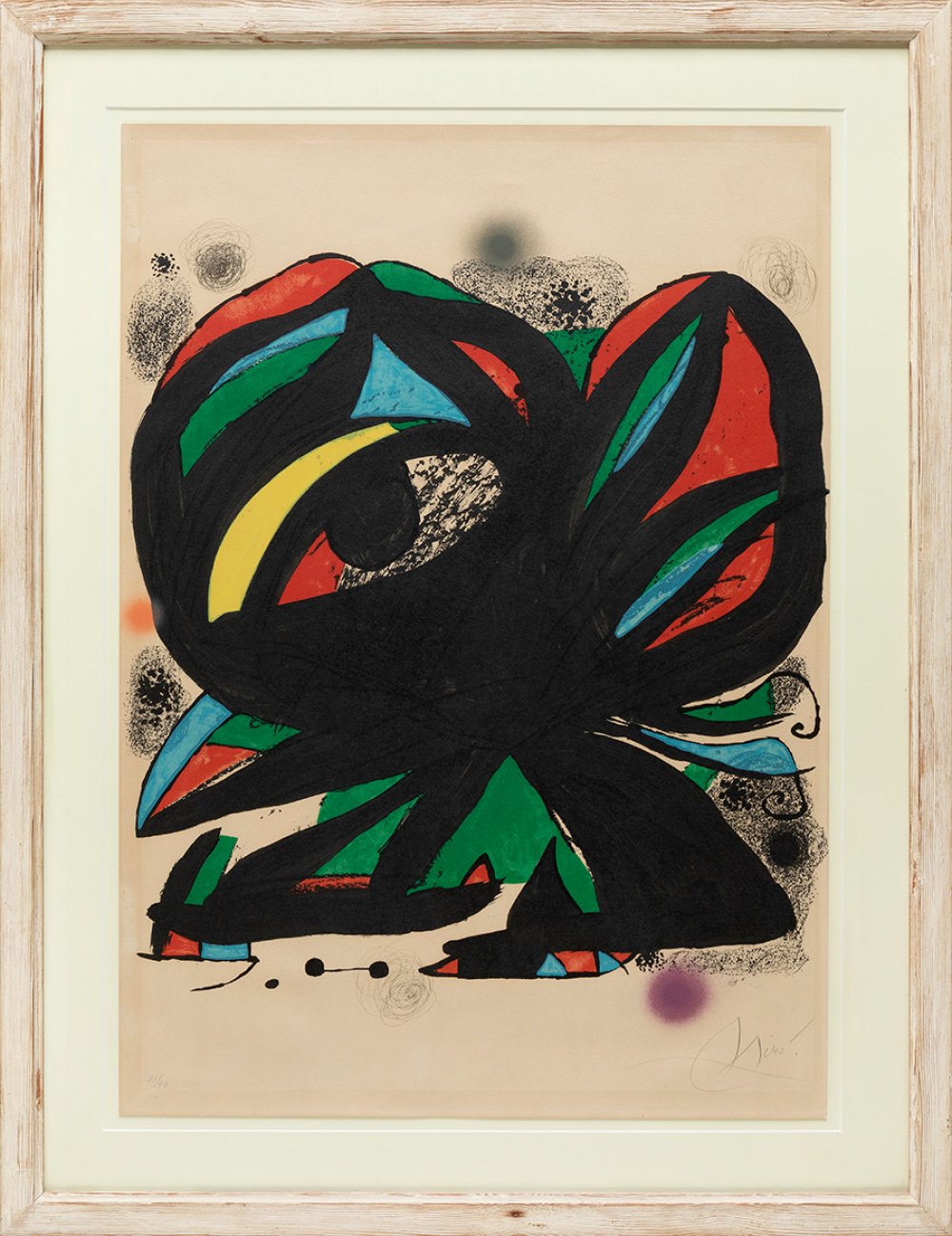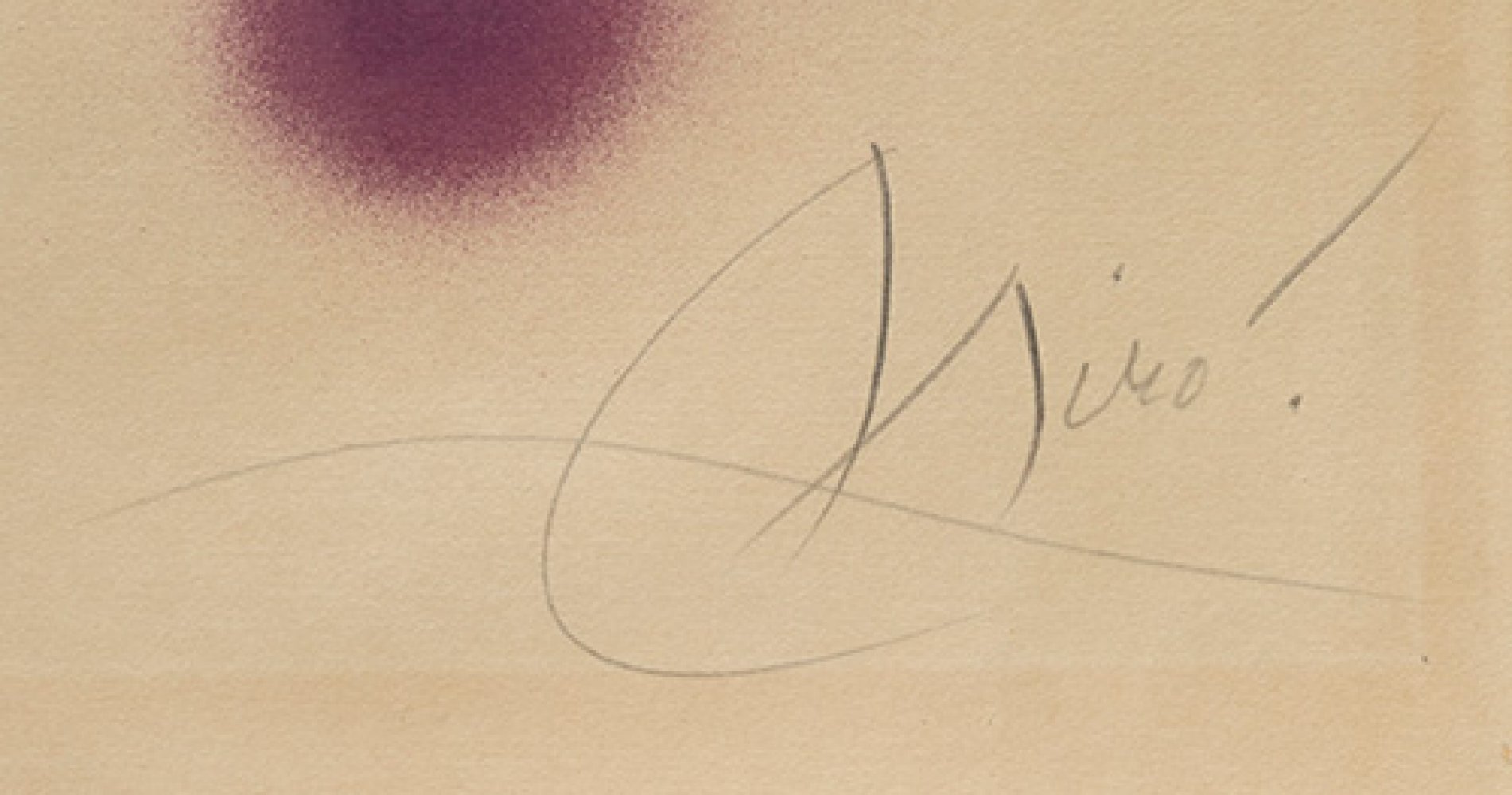82
JOAN MIRÓ I FERRÀ (Barcelona, 1893 - Palma de Mallorca, 1983)."Fundació Joan Miró", 1975.Lithograph,
"Fundació Joan Miró", 1975.
Lithograph, copy 21/99. Avant la Lettre print run.
Signed and justified by hand.
Work published in the catalogue raisonné "Miró Litógrafo. 1972-1975", Vol. V, Maeght Editeur, p. 140, ref. 1031.
Size: 70 x 50 cm; 87 x 67 cm (frame).
Joan Miró was one of the great international figures of 20th century art. He trained in Barcelona, first at the Escuela de la Lonja and later at the Academia Galí, with a more renovating spirit. At that school and at the Cercle Artístic de Sant Lluc, also in Barcelona, the young Miró met some of his great friends, such as the critic Sebastià Gasch, the poet J.V. Foix, the painter Josep Llorens Artigas and the art promoter Joan Prats. Thus, from his formative years he was in direct contact with the most avant-garde circles in Barcelona, and as early as 1918 he held his first exhibition in the Dalmau Galleries in Barcelona. In 1920 he moved to Paris and met Picasso, Raynal, Max Jacob, Tzara and the Dadaists. These were the crucial years of his artistic career, during which Miró discovered his personal language. In Paris he became friends with André Masson, around whom the so-called Rue Blomet group, the future nucleus of Surrealism, was grouped. Thus, under the influence of the Surrealist poets and painters, with whom he shared many of their theoretical approaches, his style matured; he tried to transpose Surrealist poetry to the visual, based on memory, fantasy and the irrational. From this point onwards his style began to evolve, leading him to more ethereal works in which organic forms and figures were reduced to abstract dots, lines and patches of colour. In 1924 he signed the first Surrealist manifesto, although the evolution of his work, which is too complex, makes it impossible to ascribe him to any particular orthodoxy. His third exhibition in Paris in 1928 was his first great triumph: the Museum of Modern Art in New York acquired two of his works. From the 1930s onwards Miró established himself as one of the leading figures on the international art scene and one of the key artists of the 20th century. It was precisely at this time that the artist, a non-conformist by nature, entered a phase he called the "murder of painting", in which he voluntarily renounced being a painter and experimented with other media, such as collage, drawing on paper of different textures and the construction of "objects" with found elements, his first approach to sculpture. Thus, although he soon returned to painting, Miró never abandoned his desire to experiment with all kinds of materials and techniques, including ceramics, bronze, stone, graphic techniques and even, from 1970, tapestry. He returned to Spain in 1941, and that same year the Museum of Modern Art in New York devoted a retrospective exhibition to him, which was to be his definitive international consecration. From 1956 until his death in 1983, he lived in Palma de Mallorca in a sort of internal exile, while his international fame grew. Throughout his life he received numerous awards, such as the Grand Prizes at the Venice Biennale in 1954 and the Guggenheim Foundation in 1959, the Carnegie Prize for Painting in 1966, the Gold Medals of the Generalitat de Catalunya (1978) and of the Fine Arts (1980), and was named Doctor Honoris Causa by the universities of Harvard and Barcelona. His work can currently be seen at the Joan Miró Foundation in Barcelona, inaugurated in 1975, as well as in major contemporary art museums around the world, such as the Thyssen-Bornemisza, the MoMA in New York, the Reina Sofía Museum in Madrid, the National Gallery in Washington and the MNAM in Paris.
"Fundació Joan Miró", 1975.
Lithograph, copy 21/99. Avant la Lettre print run.
Signed and justified by hand.
Work published in the catalogue raisonné "Miró Litógrafo. 1972-1975", Vol. V, Maeght Editeur, p. 140, ref. 1031.
Size: 70 x 50 cm; 87 x 67 cm (frame).
Joan Miró was one of the great international figures of 20th century art. He trained in Barcelona, first at the Escuela de la Lonja and later at the Academia Galí, with a more renovating spirit. At that school and at the Cercle Artístic de Sant Lluc, also in Barcelona, the young Miró met some of his great friends, such as the critic Sebastià Gasch, the poet J.V. Foix, the painter Josep Llorens Artigas and the art promoter Joan Prats. Thus, from his formative years he was in direct contact with the most avant-garde circles in Barcelona, and as early as 1918 he held his first exhibition in the Dalmau Galleries in Barcelona. In 1920 he moved to Paris and met Picasso, Raynal, Max Jacob, Tzara and the Dadaists. These were the crucial years of his artistic career, during which Miró discovered his personal language. In Paris he became friends with André Masson, around whom the so-called Rue Blomet group, the future nucleus of Surrealism, was grouped. Thus, under the influence of the Surrealist poets and painters, with whom he shared many of their theoretical approaches, his style matured; he tried to transpose Surrealist poetry to the visual, based on memory, fantasy and the irrational. From this point onwards his style began to evolve, leading him to more ethereal works in which organic forms and figures were reduced to abstract dots, lines and patches of colour. In 1924 he signed the first Surrealist manifesto, although the evolution of his work, which is too complex, makes it impossible to ascribe him to any particular orthodoxy. His third exhibition in Paris in 1928 was his first great triumph: the Museum of Modern Art in New York acquired two of his works. From the 1930s onwards Miró established himself as one of the leading figures on the international art scene and one of the key artists of the 20th century. It was precisely at this time that the artist, a non-conformist by nature, entered a phase he called the "murder of painting", in which he voluntarily renounced being a painter and experimented with other media, such as collage, drawing on paper of different textures and the construction of "objects" with found elements, his first approach to sculpture. Thus, although he soon returned to painting, Miró never abandoned his desire to experiment with all kinds of materials and techniques, including ceramics, bronze, stone, graphic techniques and even, from 1970, tapestry. He returned to Spain in 1941, and that same year the Museum of Modern Art in New York devoted a retrospective exhibition to him, which was to be his definitive international consecration. From 1956 until his death in 1983, he lived in Palma de Mallorca in a sort of internal exile, while his international fame grew. Throughout his life he received numerous awards, such as the Grand Prizes at the Venice Biennale in 1954 and the Guggenheim Foundation in 1959, the Carnegie Prize for Painting in 1966, the Gold Medals of the Generalitat de Catalunya (1978) and of the Fine Arts (1980), and was named Doctor Honoris Causa by the universities of Harvard and Barcelona. His work can currently be seen at the Joan Miró Foundation in Barcelona, inaugurated in 1975, as well as in major contemporary art museums around the world, such as the Thyssen-Bornemisza, the MoMA in New York, the Reina Sofía Museum in Madrid, the National Gallery in Washington and the MNAM in Paris.
27th September - Contemporary Art
Sale Date(s)
Venue Address
General delivery information available from the auctioneer
Setdart offers Worldwide shipping
PICK UP IN ROOM: You can come and pick up your lots in our offices (Barcelona, Madrid or Valencia). At the moment of the withdrawal, you will be able to accept the current conditions of the lot by means of a document that you will sign.
YOU CAN SEND ANOTHER PERSON TO PICK UP: This person must present a signed authorization that you can find in our web page by accessing from BUY AT SETDART- LOGISTICS-DOWNLOAD AUTHORIZATION DOCUMENT. You can also send an e-mail with the requested data in AUTHORIZATION DOCUMENT to admin@setdart.com
Important Information
25% buyer´s premium
21% buyer´s premium at www.setdart.com
Terms & Conditions
The maximum period to pay the lots is 7 working days. You can pay either via bank transfer or with credit card through our platform www.setdart.com (we only accept VISA or Mastercard).
BUYER´S PREMIUM: 22% Hammer price + 21% VAT from the buyer´s premium
If your piece has more than 100 years, our Ministry of Culture requires an export certificate in order for the piece to leave the country. Note that if the piece goes inside the EU, there is no cost for the export certificate. If the piece goes outside the EU, there is a cost for the export certificate. You can find more information in our Ministry of Culture website: https://www.culturaydeporte.gob.es/en/cultura/patrimonio/exportacionimportacion/exportacion/tasas.html
INQUIRIES: admin@setdart.com
Setdart guides you through the entire process, from the time of award to the day you receive your lot. Our logistics team will be happy to manage your transport, and will advise you on the best shipping method with professionals from the sector used to handling works of art and jewelry.
WE OFFER WORLDWIDE DOOR TO DOOR SHIPPING
PICK UP IN ROOM: You can come and pick up your lots in our offices. At the moment of the withdrawal, you will be able to accept the current conditions of the lot by means of a document that you will sign.
YOU CAN SEND ANOTHER PERSON TO PICK UP: This person must present a signed authorization that you can find in our web page by accessing from BUY AT SETDART-LOGISTICS-DOWNLOAD AUTHORIZATION DOCUMENT. You can also send an e-mail with the requested data in AUTHORIZATION DOCUMENT to admin@setdart.com
SETDART IS NOT RESPONSIBLE FOR THE STATE OF THE PARTS ONCE THEY LEAVE OUR FACILITIES. MRW SHIPMENTS: Once the payment is made, your lot will be packed for shipment, the logistics department will send you an e-mail notifying you of the day it leaves our warehouse, changes of address cannot be made after receiving this e-mail.
INSURANCE INCIDENTS: Coverage for the value of the auction up to 3000 ? per shipment, if the value of the auction is higher, Setdart will send you a quote including the additional insurance. The insurance company WILL NOT BE RESPONSIBLE FOR THE SHIPMENT THAT EXCEEDS THAT AMOUNT AND IS NOT FULLY INSURED. MRW INCIDENTS: Maximum notification 48 hours after receipt, after which the insurance company WILL NOT BE RESPONSIBLE AND NO CLAIMS WILL BE ACCEPTED.
E-MAIL LOGISTICS: logistica@setdart.com
PICK UP YOUR MESSAGES: You can send your own messaging, prior notice via e-mail that your shipment is ready, please note 3 or 4 days in advance. This type of shipment is packaged so Setdart will provide you with a quote.
EXPENSES FOR STORAGE: We inform you that if the purchased lot is not picked up within a month, you will be charged 30€ per week per lot. Setdart Online S.L., owner of the web site "setdart.com", "setdart.net" and "setdart.org", acts as a company of Spanish nationality inscribed in the Volume 36955, sheet 182, page B-293056 of the Mercantile Registry, with registered office at Calle Aragó












